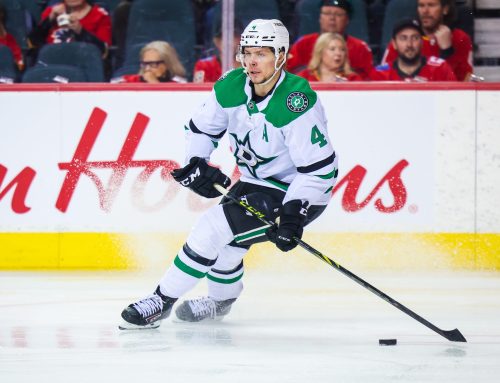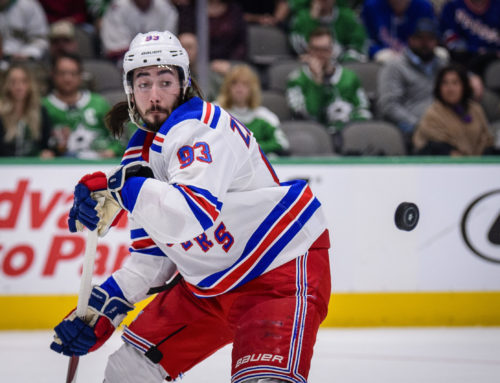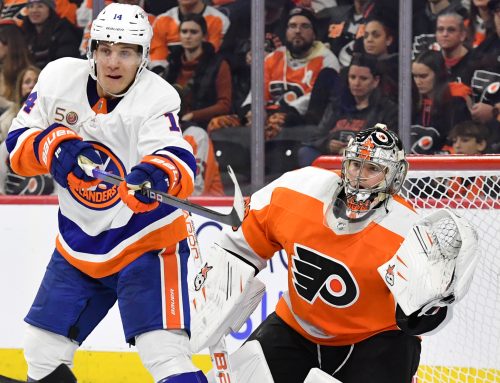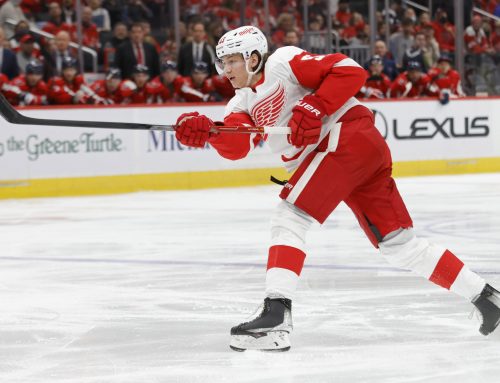Goldipucks and the Three Skaters: Teravainen, Nyquist, & Arvidsson
Rick Roos
2019-03-06

Welcome back to “Goldipucks and the Three Skaters,” which will now appear monthly as part of my new “Roos Lets Loose” column format. For first time readers, or those needing a refresher, this column is a play on the Goldilocks and the Three Bears story, except instead of there being three bowls of porridge I’m covering three skaters and declaring one too hot (i.e., doing unsustainably better than he should), another too cold (i.e., doing unsustainably worse), and a third “just right” (i.e., producing where he should be). I also assign each a 1-10 rating, indicating just how hot (rated 7-10, where 10 is the most unsustainably hot), how cold (rated 1-4, where 1 is the most unsustainably cold), or how “just right” (rated 4-7, where 5.5 is the most “just right”) he is.
The three skaters featured this week are Teuvo Teravainen, Gustav Nyquist, and Viktor Arvidsson. Stop here and see if you can guess which is too hot, too cold, and just right, then see if you’re correct after you read on.
Teuvo Teravainen
One of the omitted questions from last week’s mailbag had asked me for my thoughts on Teravainen. So I figured since I was doing a Goldipucks column the very next week, and this type of question fit the bill, I’d just cover it here instead.
Not only have Teravainen’s (TT’s) points trended upward with each season, so too – impressively – have both his ice time and primary assists rate. Together those strongly suggest he’s not lucking into his increased scoring and could be poised to do even better if the trends continue. In a similar vein, TT’s IPP has been at or above the key 70% mark in two of his three full seasons and is on tap to be above it for 2018-19 as well (at a career-best 76.3%). Also, he’s managed to keep his 5×5 team shooting percentage above (yet not too far above to be unsustainable) the key 9.0% level for 2018-19 despite his offensive zone starting percentage dropping from the 58-59% mark in his first two Carolina seasons to 53% this season.
TT also is at 3.15 points per 60 minutes mark for this season, which is being bested by only 31 other forwards this season. One reason it’s so high is he’s still not receiving 18:00 of ice time per game, and a decent chunk of his added ice time for 2018-19 is unproductive PK duty, which is an unfortunate – for fantasy – consequence of him becoming a more complete player. The good news is there’s nowhere for the ice time of a player of his calibre to go but up.
TT’s SOG rate, however, is lower than in past campaigns; and as his scoring rate has increased with each passing quarter of 2018-19, his SOG rate has dropped. I believe we’re seeing TT’s style changing before our eyes, with him turning into a pass-first player who needn’t rely as much on shooting to produce. Beyond that, TT is now driving the scoring no matter whom he plays with, as he has two or more even strength points with six different lines that include seven different players.
At first there looks to be concern regarding TT’s PPPts rate, as he nearly equalled his full-season PPPt total in the first three quarters of 2018-19. But that too is likely related to his changing style of play, as well as perhaps this being – if we disregard his 34-game 2014-15 campaign with Chicago – his “magical fourth year.”
Overall, I think Teravainen is TOO COLD since all his key stats and metrics have been trending up with each passing season on Carolina yet also still have realistic room to climb higher. But he’s certainly not ice cold, so I’m assigning him a rating of 3.5, leaving room for him to improve to point per game output, with a shot at 85-90+ if Carolina becomes more of an offensive force as a team or his ice time spikes.
Gustav Nyquist
Just when poolies were about to erase the last shred of hope of new San Jose Shark Nyquist ever coming close to living up to the potential we witnessed in his breakout 48 points in 57 games 2013-14 campaign, lo and behold at age 29 he’s on track for 63 points, igniting hopes among many that he’s a late bloomer who could produce into his 30s. Still, others are skeptical, wondering if they should use this as a chance to sell high on Nyquist, and I’m here to tell you, that’s the group you want to be in.
At the outset, we can’t ignore that Nyquist is playing his best hockey in five years during what just so happens to be the last year of his contract. Or to put it another way, when a player’s collective full season scoring rate over the previous three seasons was a mere 45 points and then he suddenly shows up – at age 29 – and sees that increase by nearly 50%, it’s inherently suspect and warning bells should be going off for poolies who’ve been burned by this kind of pre-UFA turnaround in the past.
Beyond that, his data/metrics either aren’t consistent with his track record or just plain unsustainable on their face. Take IPP for example. After it was 73.4% in his breakout 2013-14 campaign, it went down with each successive season – yes, it dropped in each of the next four seasons! Yet this season it’s shot back up to 71.0%, just when he happens to be on the verge of a UFA payday?
Hmmm……
It’s a similar story with SOG, which, after being collectively at 2.25 over the previous four seasons, is suddenly up to 2.65. And although the 11 PPPts he amassed while still on Detroit doesn’t exactly jump off the page, consider that there were only 12 PPPts scored while he was on the ice, meaning not only was their PP not too successful with him on the ice, but he somehow found a way to factor into more than 90% of the possible PPPts he could’ve amassed!
Nyquist’s IPP hasn’t been the only thing dropping with each passing campaign, as so too did his offensive zone starting percentage. Yet unlike his IPP, his OZ% managed to fall even further this season while with Detroit, making his jump in points even more inherently suspect than it already was. There’s also his secondary to primary assists ratio, which, prior to this season, was weighted heavily in favour of primary assists, with 82 of them compared to only 47 secondaries. With Detroit before being traded this season, however, he tallied 15 secondary assists to only 18 primaries, for far more secondary assists than he’s normally used to receiving, further signifying his scoring rate would be unsustainable even if it wasn’t coinciding with a contract year.
Hopefully even the most fervent Nyquist believer can see he’s TOO HOT, which is why he receives a rating of 9.25. The expectation should be once he’s paid this summer he’ll immediately revert to, at best, his usual 45 point ways, disappointing the poolies who were too optimistically stubborn to seize upon this moment to unload him in trade for a value he’ll never again come close to commanding.
Viktor Arvidsson
Perhaps no one had more consistent stats over the previous two seasons than Arvidsson, from identical point totals (61) to virtually identical SOG (246 vs. 247), to nearly the same PPPts (9 vs. 8). This season, however, despite missing a good bit of time due to an early injury he’s on pace to score at a 67 point rate. Is what we’re seeing is for real, particularly in view of his prior seasons of uniformity and him not having played as many games in 2018-19? The answer is yes, it’s for real indeed.
While Arvidsson’s already quite impressive SOG rate is even higher this season, it’s not up by very much, so, in turn, it’s unlikely that’s where the explanation lies for his uptick in scoring. His personal and team shooting percentages are both a good bit higher than his previous bests; but this was someone who, despite shooting a ton, was at 12.6% and 11.7% in personal shooting percentage in the last two seasons and above the key 9% mark in 5×5 team shooting percentage as well. Accordingly, while he’s probably gained some unsustainable benefit due to these numbers being elevated, chances are the associated boost in scoring isn’t all that much.
It’s also important to look closely at Arvidsson’s PPPts. Yes, it’s true that he’s fared poorly with the man advantage, having failed to even hit double digits in PPPts in each of his two full seasons. For 2018-19, however, he’s truly been snakebit, as his IPP with the man advantage is 11.1%, meaning he’s nabbed a point on a mere one of the nine PPPts scored while he was on the ice. Despite this, his share of PP minutes is growing for the second straight season and now sits at better than 50% for the first time in his career. So clearly the team doesn’t think he’s a drag-on man advantage production despite what the results are indicating. At worst he should have 3-5 more PPPts versus what he has now, were it not for his unsustainable bad luck on the PP; and that effectively cancels out the gains – to the extent they’re unsustainable – he’s receiving from his higher than usual personal and team shooting percentages.
Moreover, if we look at Arvidsson’s high SOG volume and low PPPt output, it tracks that of Jeff Skinner and Evander Kane, who are the only two other forwards since 2000-01 to average 3 SOG per game while scoring five or fewer PPGs in the same season three separate times by age 25. What do both Skinner and Kane also have in common? They’re on pace to best their career highs when both are right near Arvidsson’s age (Skinner is 26, Kane is 27, and Arvidsson turns 26 next month).
One other major key for Arvidsson is whereas last season Nashville sheltered the Kyle Turris line, now it’s Arvidsson’s unit enjoying a points-friendly deployment. In fact, Arvy’s 66.8% offensive zone starting percentage puts him in the top ten among all NHL forwards. Granted, there’s only one way to go from there, which is down; however, with Arvidsson responding well, he could see his OZ% stay this high. After all, look at Artemi Panarin, whose OZ% has been 75% or above (!) in three of his four seasons.
Overall, I’d peg Arvidsson as JUST RIGHT. His PP scoring – although never great – is far too low this season, essentially offsetting whatever potentially unsustainable gains he’s receiving from his personal and team shooting percentage being higher than his norms. Long story short, his current 65-70 point pace is legitimate, and he gets a rating of 5, suggesting he’s a good bet for 70+ points going forward if both his OZ% stays this high and his PP scoring gets back at least to prior levels.
**
Mailbag questions needed
I’m always in need of questions about fantasy hockey for me to answer in my monthly mailbag column. There are two ways for you to get your questions to me – (1) email it to [email protected] with “Roos Mailbag” in the subject line, or (2) send me a private message at the DobberHockey Forums with your question (my username is “rizzeedizzee”. Next week though, it's my second edition of Forum Buzz, which analyzes the hottest recent topics in the Forums, so be sure to come back for that.





 BUF
BUF N.J
N.J PHI
PHI MIN
MIN WPG
WPG VAN
VAN TOR
TOR CGY
CGY STL
STL